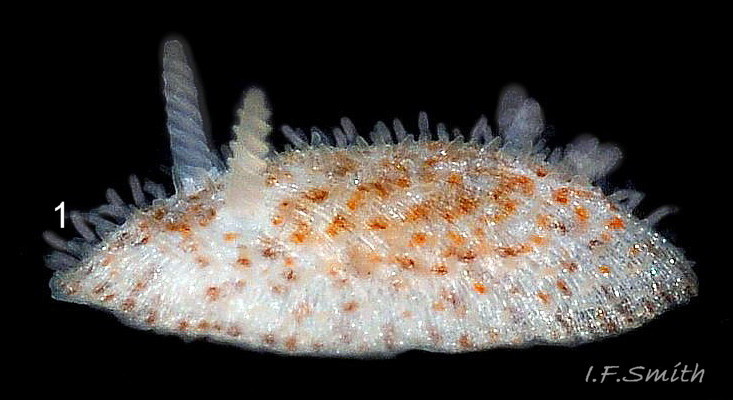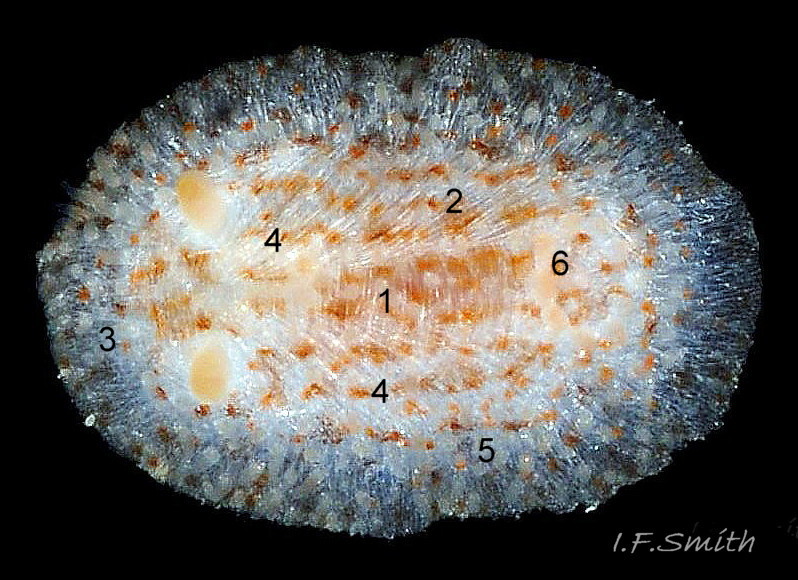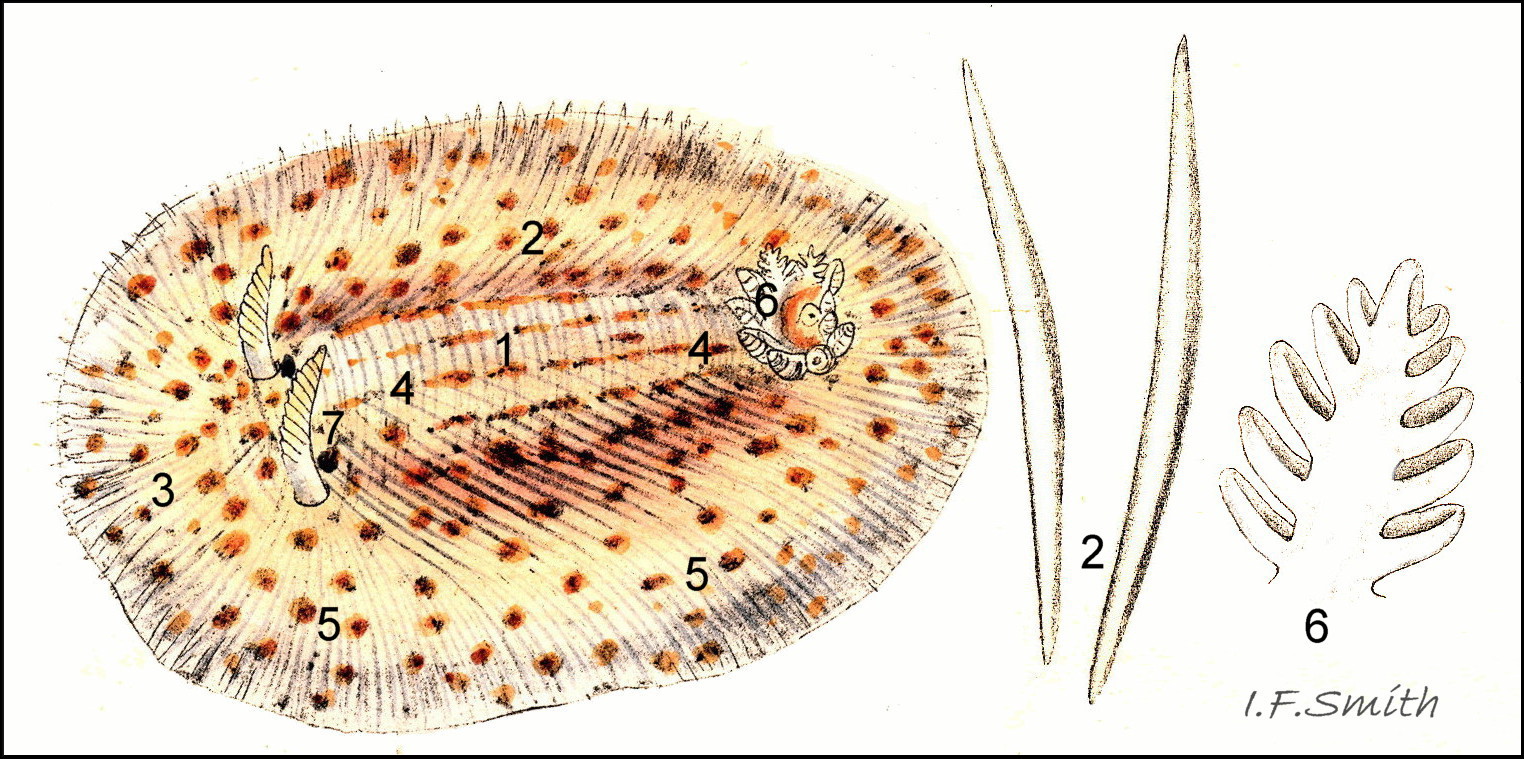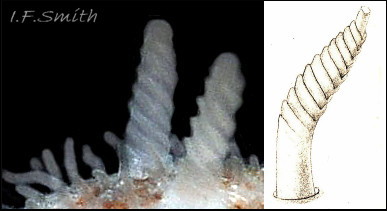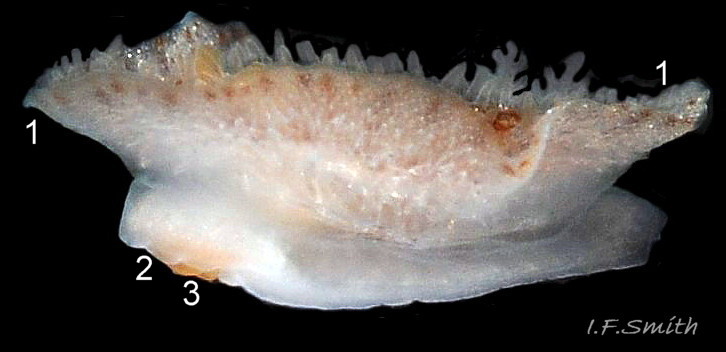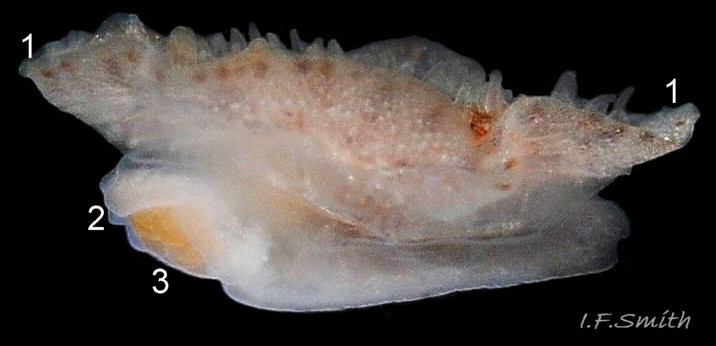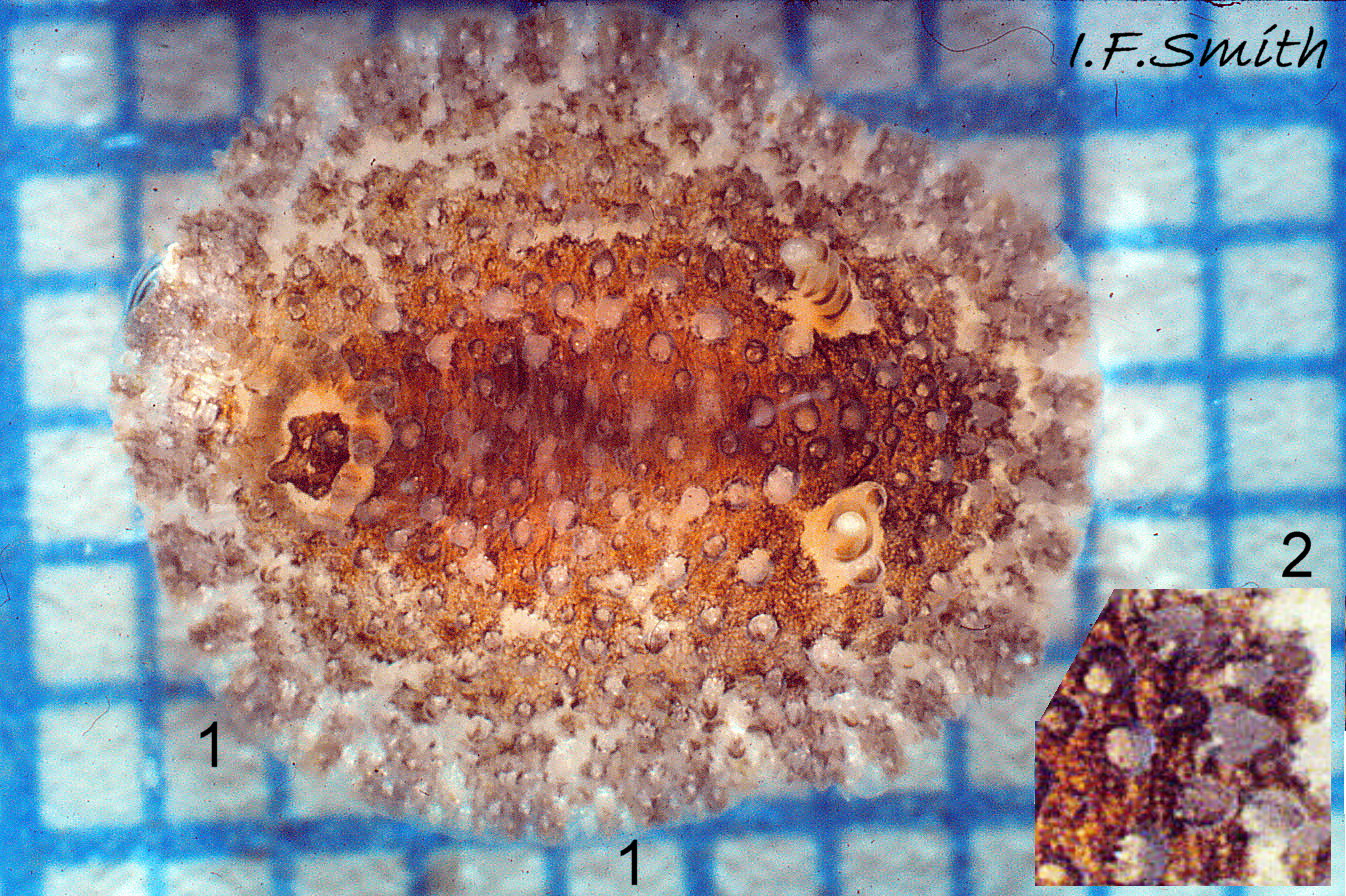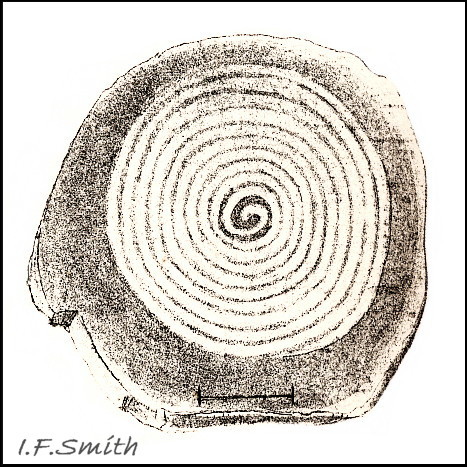Click image to enlarge with full caption. Main text below slider.
Atalodoris depressa (Alder & Hancock, 1842)
PDF available at www.researchgate.net/publication/358970018_Atalodoris_dep…
Current taxonomy: World Register of Marine Species www.marinespecies.org/aphia.php?p=taxdetails&id=1565668
Synonyms: Doris depressa Alder & Hancock, 1842; Onchidoris depressa (Alder & Hancock, 1842) Knoutsodonta depressa (Alder & Hancock, 1842)
Meaning of name Atalo = youthful, Doris = name of a sea nymph, depressa = flattened.
GLOSSARY BELOW
Description
The small body, maximum length 9 mm, has a depressed dome profile 01 Atalodoris depressa . Its outline from above is an ellipse, equally rounded at both ends 02 Atalodoris depressa . The colourless, virtually transparent mantle reveals, embedded within it, very long, glistening, glass-like spicules. On the dorsum between rhinophores and gills, they are arranged transversely. From behind the rhinophores they are arranged diagonally backwards down the sides to the periphery 02 Atalodoris depressa & 03 Atalodoris depressa . In front of the rhinophores they are arranged radially. Below the mantle, the orange brown digestive gland and other white viscera are discernible 02 Atalodoris depressa . Alder and Hancock (1845-55) stated that this was the only species of dorid in which they could see the internal eyes when adult, and they showed them clearly in their image 03 Atalodoris depressa , but the eyes are often concealed 02 Atalodoris depressa .
The surface of the mantle is covered in unobtrusive, long, linear, colourless, transparent, soft tubercles 01 Atalodoris depressa . Small reddish, orange, or purple-brown spots are arranged on the mantle in about six longitudinal lines between the gills and rhinophores, and about three concentric lines around the flanks fig 2 02 Atalodoris depressa .
The rhinophores are white, sometimes faintly orange or yellowish, with up to ten lamellae inclined obliquely upwards and forwards 04 Atalodoris depressa . The unobtrusive anal papilla is surrounded by a circle of up to twelve small, unipinnate gills 03 Atalodoris depressa which are so transparent as to be almost invisible save for a partial faint yellowish or pale orange tint 02 Atalodoris depressa .
In ventral view 05 Atalodoris depressa , the visible head is usually restricted to the mouth and large, white oral veil partially tinted faintly orange by the rest of the orange head and mouthparts behind. In anterior view, if the mantle is raised, the orange mouth parts may be seen protruding from behind the veil 06 Atalodoris depressa & 07 Atalodoris depressa .
The dorsal surface 06 Atalodoris depressa and sole 05 Atalodoris depressa of the foot are translucent white.
The asymmetric orange-brown digestive gland which extends forwards on the left of the animal can be seen clearly through the sole. The posterior of the foot is smoothly rounded without a taper. The anterior is unevenly flattened with a central indentation around the mouth. The ample mantle extends well beyond foot and head, revealing its shining spicules when viewed ventrally 05 Atalodoris depressa .
Key identification features
Atalodoris depressa
1: usual maximum length 9 mm. Profile very depressed 01 Atalodoris depressa .
2: nearly transparent, colourless mantle has small red-brown spots arranged in lines, and visible long shiny spicules 02 Atalodoris depressa & 03 Atalodoris depressa .
3: long, soft, non-spiculate, transparent tubercles on mantle 01 Atalodoris depressa .
4: asymmetric, orange-brown digestive gland extends forwards on left of animal 05 Atalodoris depressa .
Similar species
Atalodoris sparsa (Alder & Hancock, 1846) 08 Atalodoris depressa.
1: usual maximum length 8 mm. Profile depressed.
2: mantle usually red-brown, peripherally dissected into blocks by pinkish white, unpigmented gaps.
3: small, round topped, spiculose, coloured tubercles may appear as pale spots with dark outline.
4: orange-brown digestive gland does not extend forward on left.
Habits and ecology
A. depressa lives at low water spring tide and sublittorally to 15 m on hard substrate, on or near its prey, Schizomavella linearis on the underside of stones. Spots on the mantle resemble zooids of the bryozoan prey.
It is a simultaneous hermaphrodite. Spawn has been recorded in September in Britain. It is deposited as a thin pink line in a tight neat spiral of about ten turns 09 Atalodoris depressa . The salmon-pink ova are arranged two or three abreast.
Distribution and status
The distribution of A. depressa beyond Britain, Ireland and the north French coast is uncertain because of confusion with similar species in Mediterranean and a large area of the Indo-Pacific . It is regarded as rare in Britain, but is probably overlooked as it is small, nearly transparent, has a low profile and is well camouflaged on its prey. It occurs fairly regularly on Orkney shores. UK map, NBN species.nbnatlas.org/species/NHMSYS0021528505
References and links
Alder, J. & Hancock, A. 1842. Descriptions of several new species of nudibranchous mollusca found on the coast of Northumberland. Annals and Magazine of Natural History9: 31-36. www.biodiversitylibrary.org/page/2312453#page/45/mode/1up
Alder, J. & Hancock, A. 1845-1855. A monograph of the British nudibranchiate mollusca. London, Ray Society. www.biodiversitylibrary.org/item/131598#page/138/mode/1up
Thompson, T.E. 1976. Biology of opisthobranch molluscs 1. London, Ray Society.
Thompson, T.E. & Brown, G.H. 1984. Biology of opisthobranch molluscs 2. London, Ray Society.
Current taxonomy: World Register of Marine Species www.marinespecies.org/aphia.php?p=taxdetails&id=1565668
Glossary
digestive gland = large organ in gastropods which acts like the liver and pancreas in mammals to absorb food.
dorid = a sea slug in the infraorder Doridoidei; with gills and rhinophores on the dorsum; often shaped like half a lemon or grape.
hermaphrodite, simultaneous = individual acts as both male and female at the same time with similar partner(s).
lamellae = (of sea slugs) small plates on rhinophores or leaflets of gill.
mantle = (of nudibranchs) sheet of tissue forming part or all of notum (dorsal body surface).
oral veil = anterior extension of head into a flat sheet.
papilla = (pl. papillae) small, nipplelike, sensory protruberance.
rhinophore = chemo-receptor tentacle; many sea slugs have a pair on top of the head.
spicule = (in dorid seaslugs) small, slender, sharp-pointed feature mainly composed of calcite, CaCO3, and brucite, Mg(OH)2 .
